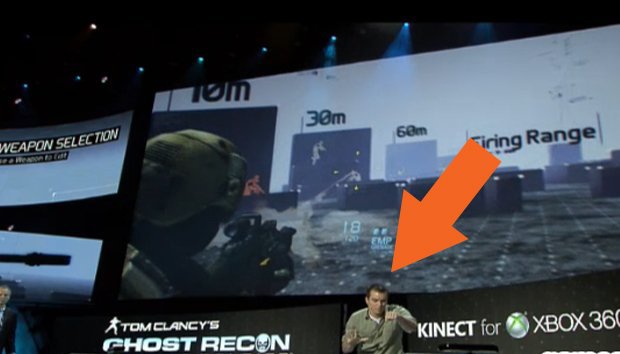E3 2011: Why Microsoft's press conference showed that it may have much bigger problems than Kinect
Naive? Out of touch? Out of date?
A case of misunderstanding
Microsoft’s need to show how Kinect can “improve” the core games you were already excited aboutwas particularly galling. Galling, and rather flailing. Aside from coming across as a worryingly desperate attempt to convince core gamers that Kinect was for them, the awkward showcase seemed to exhibit a severe disconnect from any understanding of how core gamers play their games and what they really value in the gameplay experience. Weapon customisation is a cerebral, tactical act of resource management and game balance. It is not about waving arms to navigate menus, and it is certainly not about making playground mime gestures to fire weapons.
In-combat squad command is about quick, improvisational mastery of space, and fast-thinking responses to a changing environment. It is not about the "realistic" thrill of playingcommander by using a verbal interface to order units around. Microsoft’s thinking in its ‘core Kinect’ demos was simplistic in the extreme, exhibiting a naïve approach to game design and the reasonsgamers play games.

Above: This is not why shooter fans like shooters
Worse than this misunderstanding of the needs of its core audience (and despite Microsoft’s talk of the family and kids market, there’s still a reason the core gamer is called the core gamer) was the general sense that Microsoft really doesn’t know who it’s aiming for any more, or even how to do so.
Yes, Microsoft is going for a more general entertainment audience now, butits methods in that direction, via TV, film and sports content, so far seem to offer not a new, exclusive experience but simply another avenue along which to experience what can already be found elsewhere. The internet already exists. Cable and Satellite TV already exists. iPods and Spotify already exist.
To assume that a few “magic” Kinect controls and a bit of online communication is enough to elevate the Xbox 360 to the level of de facto entertainment device implies a slight misunderstanding of the way people consume media. Immediate, easy, free of complication, ideally free, and wherever and whenever they want it. That’s how people want their media. And as I see it, nothing Microsoft currently has or has queued up equips it to effectively provideits media servicesas anything other than a secondary option. In short, it does not have enough going on to be able to shout about its offerings as “the future”.
Playing the wrong game
As for games? Again, we’re looking at a lack of appreciation of the market today. By focusing so hard on the casual, families-and-parties experience, Microsoft is swimming as hard as it can to chase a boat that left two years ago. Nintendo is arguably stepping away from that market, having milked it for as long as it could before recognising that the casual fad market is just that, and cannot be relied upon for long-term loyalty. While Sony’s press conference last night might have been light on megaton surprises, it once again confirmed an important factor. That for all of its failings, Sony’s approach to entertainment has always been a healthy, holistic one, providing for all without excluding any market.
Weekly digests, tales from the communities you love, and more

Microsoft though, to mix metaphors for good purpose, is chasing the tail of a dead horse. So excited by its Kinect hardware sales, it looks like a a mixture of single-minded Nintendo innovation-lust and messianic Sony arrogance has caused it to ignore the fact that the software attachment rate, at the time it showboated those admittedly impressive sales figures,showed a 1:1 ratiobetween hardware andsoftware. And that overrides those ten million sales with one very sobering fact. People are buying this thing, but they sure as hell aren’t using it with any great enthusiasm. Or perhaps it hasn't ignored it, and perhaps that's what last night's attempts to prove the device's core worth were all in aid of.
When you’re in the business of selling entertainment, you need to make sure that people want to keep buying what you provide. The delivery system provided by the hardware is just the start. It's what that hardware can deliver that matters. And at the moment it still looks like Kinect doesn't and can't deliver anything meaningful for Microsoft's initial and arguably most passionate audience. And if Microsoft doesn’t watch itself, and if Nintendo’s Project Café turns out to be what I, and many others,think it will be, then Nintendo could tear past in a triple-processored, 1080P speedboat and rescue the ship-abandoning core right from under its nose tonight.
June 07, 2011



